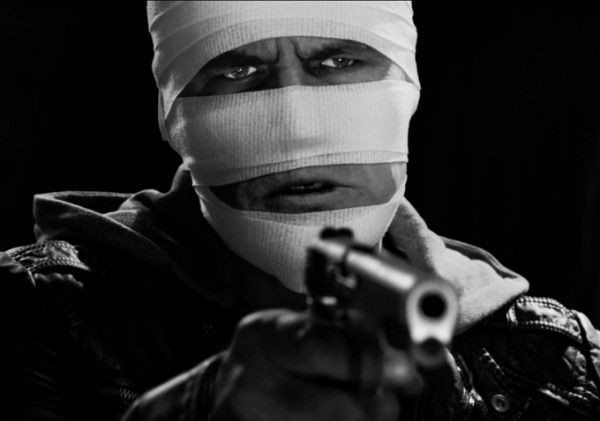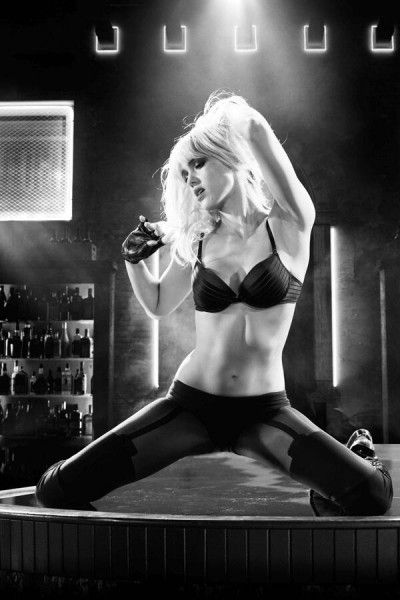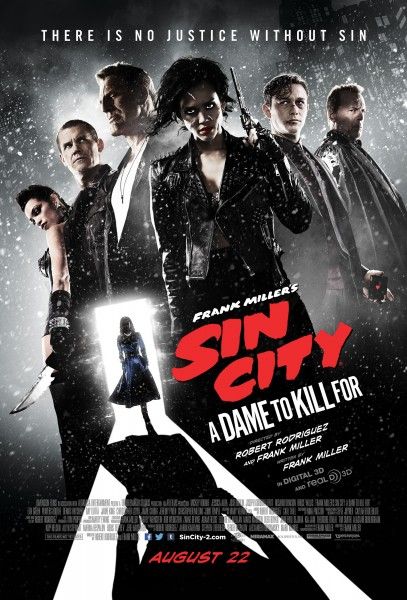Though he is not exactly a household name, Frank Miller is still one most singular and influential storytellers of the last 40 years. His miniseries The Dark Knight Returns redefined the character, allowing for more cerebral and experimental efforts like Grant Morrison’s phantasmagoric Batman: Arkham Asylum. Coupled with Alan Moore and Dave Gibbon’s Watchmen, The Dark Knight Returns helped pave the way for a whole generation of adult-oriented and serious-minded graphic novels. These novels served as the template for the gritty, hard-edged superhero fare that has dominated cineplex’s for almost a decade. And it has seeped deeply into films featuring no spandex at all. Without Miller, Tim Burton might not be an A-list director. There would certainly be no Christopher Nolan Dark Knight trilogy. No Teenage Mutant Ninja Turtles either, for that matter. And if we are to include the technological advancements of Robert Rodriguez and Zack Snyder’s respective adaptations, Miller might well be more influential to the future of filmmaking than he has been to comics. So all things considered, I think we can agree that Robocop never had any sequels and Holy Terror! exists only as an Onion article penned by David Mamet during his Andy Kaufman period.
Collider sat down with the perpetually-fedora-adorned author and artist at Comic-Con to talk about his long-awaited Sin City: A Dame to Kill For. During our exclusive one-on-one, Miller talked about adapting his own work, original material added to the sequel, the importance of trusting actors, why he never writes a comic with the movie version in mind, the future of the 300 and Sin City franchises, the possible return of Big Guy and Rusty the Boy Robot and more. Hit the jump for the full transcript.
Collider: How’s your day going so far? Enjoying the Con?
FRANK MILLER: Well, it has kept me busy.
Do you ever find these things fun? Or is it just stressful with worrying about people recognizing you and barraging you with questions?
MILLER: It’s a lot of fun and there’s a lot of interaction. I’m not going to complain about the fact that people are paying attention to my work. I suppose that wouldn’t be fair.
One of the things I wanted to know, just starting off was — you spent a lot of time between when the first Sin City came out and this new one because of various production issues, but is the story basically the same as what you set out to make in the original writing stage?
MILLER: Yes. It’s just been amplified. We were always going to start out with A Dame to Kill For as the base of it and then we chose Just Another Saturday Night to accompany it. Then we got talking and Robert [Rodriguez] suggested that we throw in some new stuff and did I have any other Sin City stories? I got a basket full and I suggested two that I thought would be appropriate for what we had. And we used them.
Do you have plans to keep publishing Sin City novels as well?
MILLER: Yes.
I don’t know how tight the canon of continuity is between all of them but, would things from the movies start showing up in the books?
MILLER: Well, it’s all the same world. It works both ways. But these characters remain true to themselves and that’s the important thing. I don’t believe I’d let one contradict the other.
So you just keep it all in your head in a sense because you know the characters?
MILLER: Yes.
Do you have any desire to - because I believe after 300 came out, you were commissioned to write Xerxes as a sequel to that - do you have any desire to just write the screenplay first without the comic, or is the comic part of your creative process?
MILLER: Well, I prefer to write and draw in the privacy of my home and with total freedom and then take it to the lion’s den.
I remember years ago, before I was doing press stuff, I saw an early test screening of 300. I went to those all the time as a kid. And I have never seen a longer line. I showed up two hours-and-a-half early and there were a line all the way around a 21 screen theater. I have never seen a bigger reaction from an audience than during that film. It was insane. And especially because of how vocal the crowd was there, I have always had the question: is the story told by an unreliable narrator who is trying to rally his troops before a battle, and who is acting as a propagandist? Or is it just very stylized?
MILLER: It’s a story told from a particular point of view. It’s not really an unreliable narrator, beyond me. Because I researched 300 for years. And then I kept exactly what I thought was cool and threw out what I thought was boring. Which is why they aren’t walking around like giant lady bugs.
I liked it looking weird and having all the ghosts masks and stuff. That’s probably the best version of that story. With 300: Rise of an Empire, it was really cool how it began before the original and then took place during and after the first one. Do you have plans for a third one that would continue the same concurrent events structure? Or is it just, if it happens, you’ll figure it out?
MILLER: I’m still working on my own version of the Grecco-Persian wars and so I’d rather not comment in relation to the movies because I don’t want to corrupt the process that I have. I find that if somebody is writing and drawing a comic book, planning it to be a movie and a game at the same time tends to lead to a pretty lame job. So I prefer to do it purely and then move on to tackle the next.
That makes sense. What new things have you learned from 300, the first Sin City and The Spirit that you applied to Sin City: A Dame to Kill For.
MILLER: Mainly to keep it fun. Robert and I were laughing half the time on set while making a movie that many people will consider grim. But it’s mostly been the same lessons learned again and again. And one lesson is to learn to work with actors and to trust them and to gain their trust and to go deeply into characters with them. And the more practice I’ve gotten with that, and the more actors I’ve gotten to work with, the more rewarding it has been.
Given that you’ve now worked with a tremendous number of really great actors, does that influence the way you write a character?
MILLER: No. When I’m writing a comic book, I’m thinking about a character that I’m going to be drawing on the page. I’ve never drawn a character to look like who I want to cast in a movie because I don’t think that way. I’m a real monomaniac. I do one thing at a time.
Sure. But when looking at a book like 300 or The Dark Knight Returns, the element of extreme pain or suffering sort of turning into a vicious-but-glorious violence, is it just cool or do you know where that comes from?
MILLER: Ask my shrink.
Is he around? [I turn to a man laying on the bed in the hotel room. It is David Wenham aka Dilios from 300] Is that him?
DAVID WENHAM: No, I’m the unreliable narrator.
PUBLICIST: He’s not the therapist, he’s the one laying down!
[Group Laughter]
Great. Now I lost my place.
MILLER: Take your time.
Okay… Way back at the beginning, obviously after you’d been writing comics for years, you wrote what became Robocop 2 and Robocop 3. And then you weren’t happy with the way it turned out. So, you made a comic that was closer to your script. And now that’s being redone in a new version? Is it just trying to get it right? Why do the same project three times?
MILLER: Well, I’m not working on the new Robocop. I wrote my scripts and a publisher asked me if they could adapt them and they hired someone else to do the actual adaptation. So really, my only involvement in Robocop has been in writing my scripts for numbers two and three.
Did you want any input, or was it more like, ‘Oh, go ahead and play with that?’
MILLER: With the adaptations?
Yeah.
MILLER: Well, they were so intentionally faithful. A friend of mine did the adapting.
You’ve been very lucky with that. With filmmakers taking, literally, panels of your work and turning it into full motion. Have there been any suggestions for adaptations that would be less faithful? Or do you feel at this point a bit spoiled where, ‘I don’t want to do it unless it’s going to look exactly like my book?’
MILLER: I sort of think I take it case by case. Because there are stories that I want to tell graphically that I wouldn’t want to tell the same way or wouldn’t want to tell at all in film. So I won’t put a sword in the sand and say, ‘Never touch a word of it.’ I know the business too well. But each format has its own rules and you adapt.
As a kid - I just found out while research for this interview - I loved this series Big Guy and Rusty the Boy Robot, which is based on some of your early work.
MILLER: Uh-huh.
Do you have any interest in making a new version of that or being a show runner on a TV series so that you could have some of the huge number of stories you’ve written on a weekly basis?
MILLER: Oh, sure. I mean, [Big Guy and Rusty the Boy Robot co-creator] Geofrey Darrow and I have tossed around ideas for The Big Guy for a while. And there is some interest. And it’s a fun story that could really be for any age. So a lot of it has to do with Geofrey and my collaboration with him.
Are you developing any TV series? Have you been approached for anything?
MILLER: I’m not working on anything like that now.
I’ve always been interested in — until you did Dark Knight Returns, the public perception of Batman was still that he was the Adam West character in a lot of ways. And you came along and now that has become the defining version. Everything since feels like it has been based-on or influenced-by that. How did you think, ‘I should make this the darkest, most fucked up thing possible?’
MILLER: Well, when I grew up, I remember enjoying the TV series a great deal. But what really captured my imagination was the extremely powerful work of Neal Adams and Denny O’Neil on the character. That inspired Dark Knight more than anything. I got all the way back to Dick Spang and Jerry Robinson and Bill Finger, but I would say that it was Neal and Denny who inspired me most.
I’m out of time, so this is my last question. Are there any easter eggs, is there anything we should know to look for in the background of Sin City 2? Any in-jokes to anything else you’ve ever made?
MILLER: That would be telling.
Should we be looking for something in the background, even if you can’t tell us what it is?
MILLER: That would be telling.
Touché.





